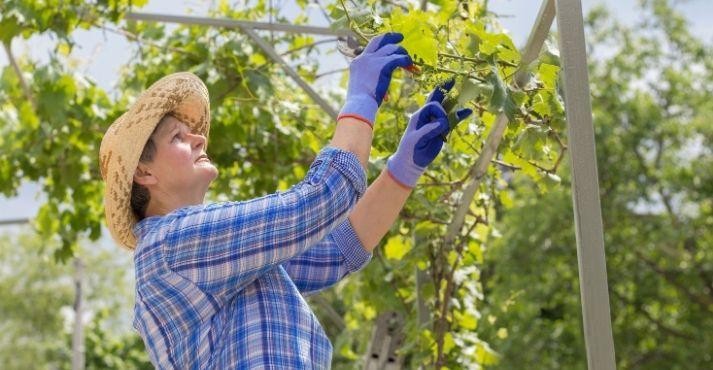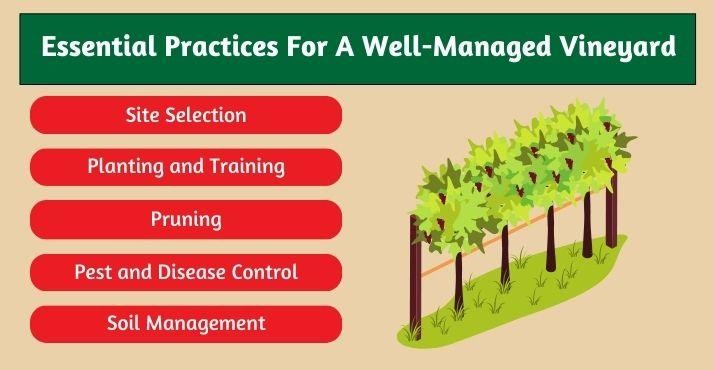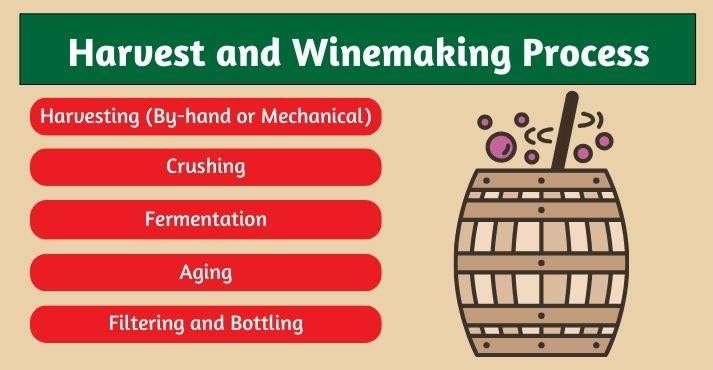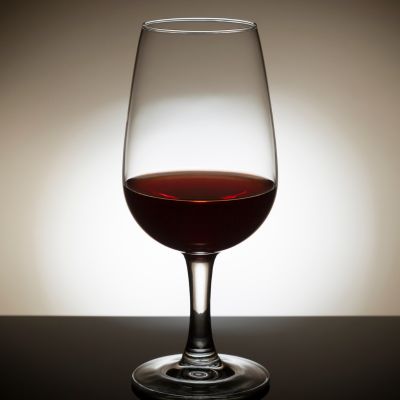What goes into producing the perfect glass of wine? Viticulture is more than just grape-growing; it’s the art and science of cultivating grapevines, shaping the flavors, aromas, and quality of every bottle.
From ancient times to modern-day vineyards, viticulture has played a crucial role in the wine industry, influencing each decision that brings grapes to life.
This glossary explores how viticulture impacts winemaking and covers essential aspects of grape-growing, including site selection, pruning, and harvesting.
You’ll also discover the difference between viticulture vs. viniculture and explore the future of viticulture through advancements in technology and sustainable wine practices. Ultimately, you’ll understand what viticulture is and why it’s vital for making quality wine.
What is Viticulture?

Viticulture is the study of wine and the art, science, and practice of growing grapevines, specifically for wine production.
This field encompasses everything related to grape growing, from the early stages of planting to the final steps of harvesting. The term comes from the Latin word “vitis,” meaning “vine.”
Viticulture is central to the wine industry because it influences the flavor, aroma, and overall quality of the wine. Practitioners of viticulture working with various factors, such as soil type, climate, pest control, and pruning techniques, to achieve the best possible results from their grapevines.
Unlike viniculture, which involves turning grapes into wine, viticulture focuses purely on cultivating the highest-quality grapes, laying the groundwork for winemaking.
History of Viticulture
Ancient Origins of Viticulture
Viticulture has a history dating back thousands of years, with origins deeply rooted in ancient civilizations. Wine and grape-growing were integral to societies, often featured in religious ceremonies, social gatherings, and as symbols of wealth.
The study of wine and winemaking practices is believed to have started around 6,000-5,000 BCE in the Middle East and Eastern Europe.
- Mesopotamia: Known as the “cradle of civilization,” Mesopotamia was among the first regions to grow grapevines. Wine production was highly esteemed, and grape-based beverages were a part of everyday life.
- Ancient Egypt: Egyptians valued wine for religious rituals and as offerings to their gods. Pharaohs and nobles enjoyed wine as a status symbol. Egyptian tomb art often depicts grape harvesting and winemaking processes, showcasing some of the earliest viticulture techniques.
- Roman Empire: The Romans played a significant role in spreading viticulture across Europe, establishing vineyards in France, Spain, and Britain. Roman innovation in pruning, trellising, and soil management set the foundation for modern viticulture. Their expertise in grape-growing influenced the future of Europe’s wine industry.
This ancient history reveals how viticulture evolved alongside civilization, becoming essential for cultural and economic development.
Evolution of Modern Viticulture
Through the centuries, viticulture practices advanced, shaping today’s vineyard management.
- Middle Ages: Monasteries in Europe safeguarded and refined viticulture techniques as monks grew vineyards for communion wine. This period marked the beginning of distinguishing grape varieties, as monks noticed unique flavors based on the region’s terroir.
- 16th to 18th Centuries: European explorers spread viticulture practices to the Americas. Spanish and Portuguese explorers planted grapevines in their colonies, initiating new viticulture traditions worldwide.
- 19th Century: The arrival of Phylloxera, a devastating pest, challenged European vineyards. Grapevines were grafted onto resilient American rootstocks to save the industry, a method still used today.
Today, viticulture merges tradition with innovation, drawing on centuries-old techniques alongside modern approaches.
Concepts like natural wines and biodynamic wines focus on eco-friendly practices, preserving the environment, and improving grape quality alongside viticulture transformation.
Vineyard Management: Essential Practices

In viticulture, vineyard management is essential for growing healthy, flavorful grapes. Each step in managing a vineyard, from selecting the site to managing the soil, impacts the final wine quality. Here are some of the core practices in vineyard management:
1. Site Selection
Choosing the right location, also known as understanding the terroir, is fundamental in viticulture. Terroir refers to the combination of climate, soil, and topography that influences how grapevines grow and their flavors.
In Southeast Asia, unique challenges like humidity and heat require selecting specific grape varieties that can withstand tropical conditions.
Key factors in site selection include:
- Climate: Grapevines need the right balance of sunlight, temperature, and rainfall. A warm climate can produce bolder, fruitier wines, while cooler regions may yield grapes with higher acidity.
- Soil: Different soil types, such as clay, limestone, and sandy soils, impact the vine’s growth and the wine’s character. For instance, volcanic soils in parts of Indonesia add unique minerals to the grapes.
- Topography: The slope of the land affects sun exposure and drainage, both crucial for vine health.
2. Planting and Training
The planting phase in viticulture involves selecting healthy vine cuttings or grafted plants suited for the vineyard’s specific conditions. Once planted, grapevines need a support system for optimal growth, known as training.
- Training Systems: Vines can be trained using various systems, such as trellises, which hold the vines in place and allow maximum sun exposure and air circulation.
- Row Orientation: Placing the rows to receive adequate sunlight throughout the day promotes even ripening and improves grape quality.
3. Pruning
Pruning is a crucial step in grape-growing that directly impacts yield and quality. When removing excess growth, pruning helps direct the plant’s energy toward producing fewer but higher-quality grapes.
- Winter Pruning: This practice involves removing old growth during the dormant season, allowing for better control over grape production in the coming season.
- Summer Pruning: During the growing season, pruning is used to manage the plant’s canopy, improving airflow and sun exposure to prevent disease and aid in ripening.
4. Pest and Disease Control
Keeping grapevines healthy involves managing pests and diseases, especially in regions with humid climates where issues like mildew can affect the crop. Modern viticulture combines natural and technological solutions to protect vines.
- Natural Solutions: Farmers often use organic pest repellents or integrate animals like ducks in vineyards to control insects naturally.
- Technological Solutions: Drones and sensors help monitor vineyard health, enabling precise, targeted treatments for pest control without harming the environment. In Southeast Asia, the rising popularity of natural wines has encouraged many vineyards to adopt organic pest control methods to meet consumer demand.
5. Soil Management
The soil’s health is vital in viticulture, providing essential nutrients for grapevine growth. When understanding soil composition and managing it carefully, farmers can boost both vine health and grape quality.
- Soil Testing: Regular soil testing allows viticulturists to monitor nutrient levels and pH, ensuring optimal growing conditions.
- Cover Crops: Planting cover crops, like clover or grasses, helps improve soil fertility and prevent erosion.
- Composting: Many vineyards use compost to enrich the soil, promote sustainable wine practices, and support biodiversity.
Effective soil management also aligns with eco-friendly practices, leading to a healthier environment and high-quality grape production.
Harvest and Winemaking Process

The journey from vine to wine culminates in the harvest and winemaking stages. Timing and careful handling during this process are crucial for preserving grape quality and ensuring that the final product reflects the vineyard’s unique characteristics.
1. Harvesting
The timing of the grape harvest is one of the most important decisions in viticulture. Harvesting too early or too late can dramatically affect the wine’s flavor, acidity, and sugar content.
Factors like grape ripeness, weather conditions, and vineyard location play a role in determining the optimal harvest time.
- Hand-Picking vs. Mechanical Harvesting: Many traditional vineyards prefer hand-picking, as it allows for selective harvesting and gentle handling of the grapes, minimizing damage. However, mechanical harvesting is often used for efficiency in large commercial vineyards.
- Timing and Weather: In regions with unpredictable weather, such as tropical climates in Southeast Asia, choosing the right harvest time becomes even more critical. Rain can cause grapes to absorb too much water, diluting the flavors. For example, some vineyards in Thailand monitor weather patterns closely to avoid rain during harvest season.
2. Winemaking Techniques
After the grapes are harvested, they move into the winemaking process, which includes several key steps:
- Crushing: Traditionally done by foot, grape crushing is now usually mechanized to quickly release the grape juice while protecting the seeds from being crushed, which could add bitterness.
- Fermentation: This is where the magic of winemaking happens! The grape juice is transferred to fermentation tanks, where natural or added yeasts convert the sugars into alcohol. Different fermentation techniques can produce a wide range of flavors. For instance, natural wines rely on wild yeasts on the grape skins for fermentation, creating a unique, earthy taste.
- Aging: Once fermentation is complete, the wine is aged in barrels, typically oak or steel, to develop its flavors further. Oak barrels add complex flavors like vanilla or spice, while steel preserves the wine’s fruity characteristics. Depending on the desired outcome, aging can range from a few months to several years.
- Filtering and Bottling: The final steps involve filtering out impurities and bottling the wine. While some winemakers prefer minimal filtering to keep more natural flavors, others filter more heavily for clarity. Bottling requires careful sealing to preserve the wine’s quality until it reaches consumers.
The harvest and winemaking processes underscore how viticulture and viniculture work together to bring out the best qualities in wine.
Each technique, from harvest timing to fermentation style, contributes to the flavor profile, body, and aroma, crafting a wine that truly represents its vineyard.
Viniculture vs. Viticulture
Though closely connected, viticulture and viniculture refer to two different aspects of the wine industry. Comprehending these distinctions helps clarify the unique roles each plays in creating quality wine.
- Viticulture: This wine term encompasses the entire grape-growing process, focusing on cultivating healthy, flavorful grapes. It involves managing the vineyard, from selecting the site and soil to pruning, pest control, and harvest timing. Everything done in viticulture aims to produce grapes yielding the best possible wine.
- Viniculture: Once grapes are harvested, viniculture takes over. This field deals with the study of wine and winemaking, turning grapes into wine. Viniculture involves fermentation, aging, blending, and bottling, all shaping the wine’s final taste and quality.
In simple terms, viticulture is about growing grapes, while viniculture is about making wine. Each contributes to the quality of the wine in different ways.
Without skilled viticulture, the grapes may lack the depth and complexity needed for high-quality wine; without precise viniculture practices, even the best grapes might not reach their full potential. This balance between viticulture and viniculture creates a great bottle of wine.
Comprehending the full journey from vine to bottle deepens our appreciation for the wine industry and the skillful craft involved in each glass.
Future of Viticulture
As the wine industry evolves, so does viticulture. Vineyards worldwide are adopting technology and sustainability to improve grape quality, manage resources, and adapt to climate change. Here’s a look at how the future of viticulture is shaping up.
1. Technological Innovations
New technologies are transforming viticulture, making it more precise, efficient, and environmentally friendly. These advancements enable vineyard managers to monitor every aspect of grapevine health and growth, helping them make data-driven decisions.
- Precision Viticulture: Precision viticulture uses GPS, satellite imaging, and soil sensors to track vineyard conditions. When analyzing temperature, moisture, and vine health data, vineyard managers can target specific areas of the vineyard, applying water, nutrients, or pest control only where needed. This approach reduces waste and develops grape quality.
- Drones: Drones offer a bird’ s-eye view of the vineyard, capturing images that reveal patterns invisible from the ground. They help identify areas stressed by drought, pests, or diseases, allowing for rapid response. Many vineyards in Southeast Asia, like those experimenting with new natural wines in tropical regions, are adopting drones to better manage challenging climates.
- Data Analytics: Collecting and analyzing data allows vineyards to predict grape yield, optimize harvest timing, and improve overall vineyard health. With data analytics, vineyards can anticipate how weather changes impact growth, helping them make proactive adjustments.
2. Sustainability Trends
Sustainability has become a core focus in modern viticulture. As consumers demand more eco-friendly options, vineyards adapt to practices prioritizing environmental health.
- Organic Farming: Organic viticulture avoids synthetic chemicals, relying on natural methods for pest control and soil health. Vineyards that use organic fertilizers and compost can protect the ecosystem and promote biodiversity. This trend is growing in regions like Singapore and Thailand, where consumers are increasingly interested in eco-friendly options.
- Biodynamic Wine: Biodynamic practices view the vineyard as an interconnected ecosystem, using holistic approaches that align with natural rhythms. Biodynamic viticulture incorporates specific soil preparations, moon-phase planting, and animal integration to create a self-sustaining vineyard. This method, popular with biodynamic wine producers, prioritizes the health of the vines and soil.
- Water Management: In water-scarce areas, efficient irrigation systems and water-saving technologies help conserve resources. Some vineyards use recycled water or advanced drip irrigation to reduce water use. This approach is especially relevant in Southeast Asia, where high temperatures demand careful water management to maintain vine health.
Conclusion
Viticulture is at the heart of the wine industry, shaping every aspect of a wine’s journey from grape to glass.
Viticulture ensures that each grape’s unique flavors and aromas are fully realized through thorough vineyard management, grape-growing decisions, and innovations in technology and sustainability.
From its ancient origins to modern advancements, viticulture combines tradition with innovation, bringing a deep appreciation for the study of wine and its roots.
As we’ve explored, viticulture influences many factors—from the terroir that imparts distinct qualities to grapes to the sustainable practices that protect the land.
Knowing what viticulture is and what it entails allows us to appreciate the craftsmanship behind every bottle of wine.
Viticulture will continue to evolve through biodynamic methods, precision technologies, or natural wines that reflect the earth, supporting both the environment and the global wine industry.












